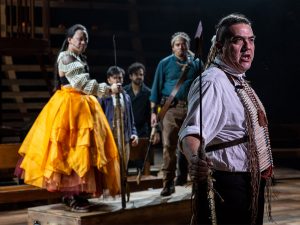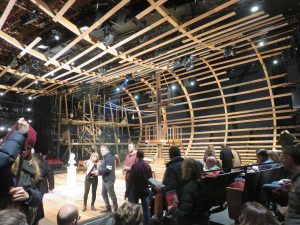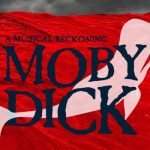Disclaimer: this review has been written and edited a while after I have seen the show because of traveling-related issues. I do believe my opinions haven’t changed a lot from since I have seen the production but they have had their time to marinate so feel free to keep that in mind when reading my review.
Dave Malloy, a composer known for his inexhaustible creativity, has now after tackling ‘War and Peace’ in Natasha, Pierre and the Great Comet of 1812, Smartphone-addiction in his A-Capella musical Octet, and the musical Preludes based on Sergei Rachmaninoff’s life, taken on the enormous task of taking down the Great White Whale: Herman Melville’s ‘Moby Dick’ in Moby Dick, a Musical Reckoning. At first I thought the ‘a Musical Reckoning’ part of the title of this production alluded to the fact that the entire book is about the reckoning of Ahab with the beast that took his leg, with the ‘musical’ part just added to clarify the genre of the play. But after seeing the show I’ve come to realize that this isn’t a musical reckoning by Ahab of the titular White Whale, it is a musical reckoning by Dave Malloy of the 100+ chapter book. And once you see the show through that perspective, it starts to make a bit more sense.

The show opens with a sermon, a speaker tells us the fable of Jonah and the Whale and reminds us ‘We Are All in the Belly of the Whale,’ we then get introduced to a character who later instructs us to call him Ishmael, but whom I have come to recognize as a form self-insert by Dave Malloy. This character starts of by telling us about the ‘Etymology’ of the book, introducing some of the themes. He then introduces us, in a way that reminded me of the prologue from Natasha, Pierre and the Great Comet of 1812, to all the characters that are aboard the Pequod, all except Captain Ahab. In a surprising turn of events Ishmael takes some of the audience members on board of the Pequod for the second part in which we learn a lot about Whaling, the different kinds of whales and how to cook them. We also get introduced to Fedallah, the mysterious Persian whom Ahab has hired as an expert harpooner. Near the end of the second part the Pequod meets the Bachelor, another whaling boat who has met Moby Dick and survived to tell the tale. The captain of the Bachelor however is more high-spirited than Ahab after losing a limb to the beast, and Ahab turns away the offer to seek land to sell the whale-oil they have harvested. They sail on to kill the beast. The third part focusses on the shipmate Pip, a young boy who loses his sanity after being stuck adrift in the sea for over an hour. Just before the final hunt for the beast starts we once again meet another captain affected by Moby Dick, one final time they try to convince Ahab to let his hunt go and to return to Nantucket. They fail. People who have read the book, mad respect, will know if they succeed in killing the great white whale.

The cast is one of the most diverse groups of people to be seen on stage, as has become a staple of Rachel Chavkin (Director) and Dave Malloy collaborations. But this isn’t just because of their creative choices, the book already adds a Native American, Native Pacific Islander, African American and Persian to the boat’s crew. Rachel further ‘race-bends’ the other ‘old white men’ on board to women of color. But they don’t let it go unnoticed, they write acknowledgement of their casting into the text of the play. This becomes particularly interesting when Fedallah introduces himself. Fedallah is a character of Persian decent and does not get the same treatment as the other ethnically diverse shipmates. He gets described as ‘weird’ and is supposed to be vaguely menacing, wearing a turban of ‘his own white hair.’ Eric Berryman portrays this character and immediately after his character’s introduction he stops the show and steps out of the narrative, starting a pseudo-stand-up routine directly aimed at a bust of Herman Melville. He comments on the fact that people immediately assume the character is Muslim, explains the actual origins of the character and then also comments on the color conscious casting and how it even erases racial commentary that could have been made. The stand-up routine is not only hilarious but it is a very interesting meta-commentary not only on the book but the production in and of itself, especially because it completely breaks with the narrative. There are multiple of these interesting meta-theatrical experiments in built into the show’s text, and they make the show very interesting to actively examine. It allows you to think during the show.
Of the racebended shipmates Starr Busby, portraying Starbuck, has undoubtedly the hardest part acting-wise. She is the first shipmate who in the narrative has the impossible task of trying to convince Captain Ahab to quit chasing Moby Dick. Textually the conversations between her and Ahab are the most beautifully crafted in the show. I don’t know how much of this is Melville and how much was Malloy but the conversations between Starr Busby and Tom Nelis are the most traditionally theatrical and a stand-out in the show. Tom Nelis as Ahab matches Star Busby in acting prowess, logically the only old-white-male in the cast he brings a certain subtlety to Ahab that sets him apart from the ‘crazed, obsessed Pirate’ stereotype. Morgan Siobhan Green as Pip is convincing as a nine-year-old and shows and shocks the audience with her descent in the third part. Eric Berryman isn’t the only character to break the fourth wall, Manik Choksi as Ishmael is another prominent character to break it. like I said before Ishmael feels like a self-insert by Malloy, he constantly comments on the length of the book and he ties the parts together with outside commentary, it is therefore no wonder he narrates the ‘Etymology’ and ‘Cetology’ parts of the story.

The last actor I want to mention is Dawn L. Troupe, she plays multiple characters throughout the show. She starts us off as Father Mapple who gives the sermon and comes back as the multiple captains from the ships the Pequod meets. Her portrayal of Gardiner, the captain of the Rachel, is particularly interesting because it shows a very motherly character despite the character being very obviously white and male in the novel seeing a black woman crying for the loss of her son at see somehow gives the character another layer of depth.
You are never distracted by the design but it does tell it’s own story.

But Dawn’s portrayal of these characters is made even more interesting by the choices Brenda Abbandandolo, the costume designer. Visually she strings together all of Dawn’s characters by giving her the same base-costume upon which she builds all the various characters: a huge hoop dress. That base-design could be read as a blank canvas, because she portrays multiple characters and this sets her apart from the others who mostly only portray one character, but it could also be read as an intentional link in which you can analyze the link between those specific characters. Brenda’s costume design overall is strong, using period appropriate costuming but mixing it with just the right amounts of modern and culturally appropriate designs to create visual consistency, you’re never distracted by the design but it does tell it’s own story. The same could also be said about Mimi Lien’s scenic design, who has said in earlier interviews to have been inspired by Quaker meeting houses. The enormous wave of wood she builds grows out from the stage and encompasses the ceiling above the audience as if to reassure the statement from the sermon: we are all in the belly of the whale.
Although I am talking about a lot of individual accomplishments in this show I don’t think they could have been possible without Rachel Chavkin in charge. Dave Malloy as writer and composer creates such a mix of modern and classic it takes a visionary director to visualize that on stage. Rachel Chavkin has of course already proven to be able to bring Malloy to the stage with Great Comet but in this show she seems more confident to go out there. The form they use is less musical than what we are used to and more akin to what the Dutch would call ‘Contemporary Musical Theater’ it is daring and it deserves praise for it.
Moby Dick is a very interesting and experimental exploration of American Literature but above all of American Culture and having seen this first almost pure outing of that makes me a little bit scared of what’s next. Because the creative tact by these artists can only be toned down for commercial reasons (don’t forget that the current show clocks in at over 3 hours) and I dread what might be cut.
Seen on: 12/21/2019, Seen at: The Harvard Loeb Dramatic center (American Repertory theater).Writer, Composer, Orchestrator: Dave Malloy, Director: Rachel Chavkin, Choreographer: Chanel DaSilva, Music Supervisor/Music Director: Or Matias, Scenic Designer: Mimi Lien, Costume Designer: Brenda Abbandandolo, Lighting Designer: Bradley King, Sound Designer: Hidenori Nakajo, Puppet Design & Puppet Direction: Eric F. Avery, Wig, Hair, & Make-Up Design: Rachel Padula-Shufelt, Casting: Stewart/Whitley, Production Stage Manager: Geoff Boronda


